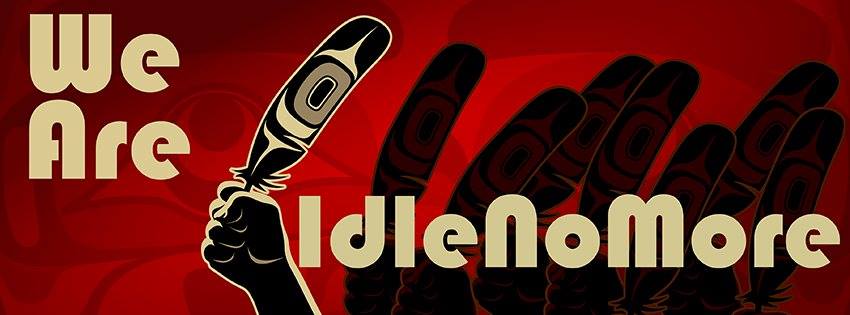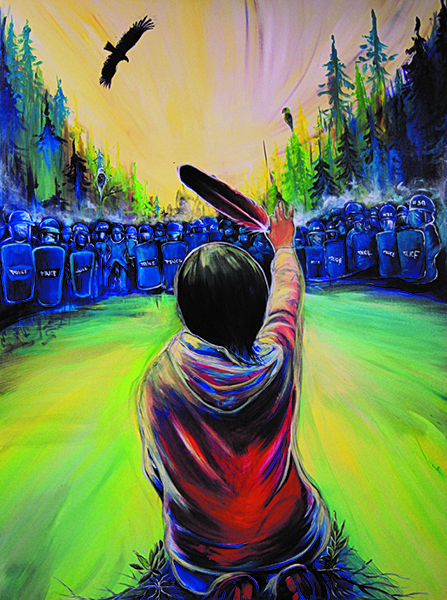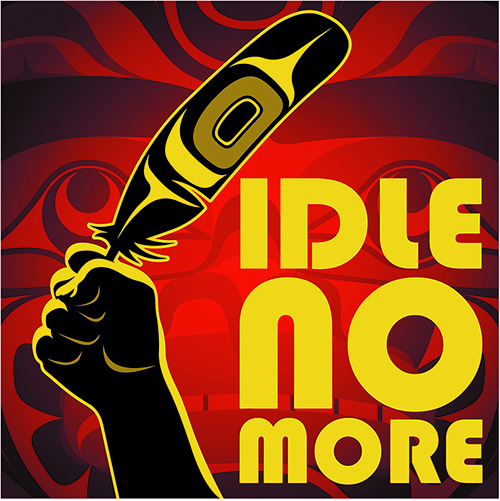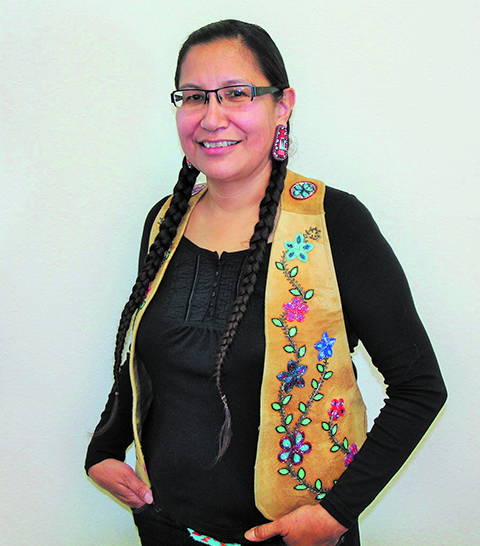
By Micheal Rios, Tulalip News
Sylvia McAdam (Saysewahum) has garnered respect from around the globe as a cofounder of the international movement Idle No More. Hailing from the Treaty 6 lands of modern day Canada, she’s travelled the continent to support countless First Nations and Native American tribes in their efforts to defend and protect sacred lands, waters, and animals.
Sylvia is a citizen of the Cree Nation and proudly holds a Juris Doctorate (LL.B) from the University of Saskatchewan and a Bachelor’s of Human Justice (B.H.J) from the University of Regina. She is a recipient of the Carol Geller Human Rights Award, Foreign Policy’s Top 100 Global Thinkers Award, 2014 Global Citizen Award, and has received several eagle feathers from Indigenous communities that she holds dear. A law professor at the University of Windsor, Sylvia is routinely asked to speak on her experiences defending Indigenous rights and participating in Indigenous-led protest movements.
Idle No More started in November 2012, among Treaty People in Manitoba, Saskatchewan, and Alberta protesting the Canadian government’s dismantling of environmental protection laws, endangering First Nations who live on the land. Born out of face-to-face organizing and popular education, but fluent in social media and new technologies, Idle No More has connected the most remote reserves to each other, to urbanized Indigenous people, and to the non-Indigenous population.*
Led by women, and with a call for refounded nation-to-nation relations based on mutual respect, Idle No More rapidly grew into an inclusive, continent-wide network of urban and rural Indigenous working hand in hand with non-Indigenous allies to build a movement for Indigenous rights and the protection of land, water, and sky.
Because colonization has dramatically caused the heartbreaking loss of Indigenous languages, customs and traditional lifeways, Sylvia uses the oral tradition of her people to share her dream to revitalize Indigenous nationhood. It is Sylvia’s dream, shared by many Indigenous peoples, that freedom, liberation and self-determination will lead Indigenous peoples away from the pain of genocide and colonialism.
Following a riveting presentation at the World Issues Forum, she honored See-Yaht-Sub staff with a sit-down interview to discuss several issues that are of utmost importance to Indigenous peoples and communities.

SYS: During your presentation you mentioned as Indigenous peoples we shouldn’t identify as an ‘environmentalist’ or ‘activist’, but instead view ourselves as defenders of our homeland. Why is that?
“When you begin to identify as an environmentalist or activist there’s a fear that arises because those terms can be associated with economic terrorists. The fear is rooted in the belief that environmentalism and activism affect the economy. That’s part of it, the other part is activism and environmentalism infers that there is no inherent connection to the land; you just show up and protest. However, when it comes to Indigenous people doing this kind of work, their connection, attention, and investment to the land is much different. Our history is written on the land, our ancestors are buried here, that land is our home. So we are defending and protecting our home. Being defenders of our homeland shifts the thinking, as it should, because our connection with the land is unique.”
SYS: Viewing ourselves as defenders of our homeland also unites us, regardless of citizenship as Native Americans or First Nations people. As defenders of our homeland we become a common people with a set of common goals, right?
“Absolutely. When you are born you are born not only as a human being, you are born into lands. When we go home we have a very clear set of lands that we are born into and we have a responsibility and obligation to protect those lands. That’s what I continue to do every day and that’s why I tell people, ‘when you know your lands you will know your relatives.’ I’m not just talking about the human relatives, I’m talking about the land, the plants, and all the animals, the flyers, the crawlers and the swimmers. Those are all our relatives and right now they have no agency to defend and protect themselves. That’s where we need to step up because the forces that threaten our land and humanity are very identifiable right now. Those forces are the extractive corporations that are going into our lands, almost in a frenzy, to take the very things we need to sustain us.”
SYS: Some of the forces that continue to threaten Native culture and Indigenous identity are more covert than others. You mentioned the term ‘ethnocide’ earlier. Can you explain what ‘ethnocide’ is?
“We speak about genocide, but people forget about ethnocide. Ethnocide is the death of the way of being of people; the things that we need to carry us on as a people. Ethnocide is the taking of our trees, the taking of our water, and
the taking of our plants. What then do we have to carry our ceremonies on? The ceremonies are pivotal and integral in who we are as a people. If you could not have trees to make your canoes, what then? If there are no trees then there are no forests to harvest from. If the waters and oceans are poisoned and you can no longer perform your ceremonies, then what happens to your songs and the language? How does your culture live on? You lose who you are as a people. That’s ethnocide.”

He explains, “Going to my first rally in 2012, I needed a poster to bring along. Knowing that the fist and feather with its image of strength and spirituality was quickly becoming the symbol of the movement, I thought it would be fitting if I created one in the formline style indicative of the west coast. I quickly drew up this image at my dining room table and then put it on my Facebook page and it suddenly went viral. Soon, this image appeared on poster boards, buttons, t-shirts, stickers and banners. My feeling was that I wanted this image to go out into the world and find a life of its own. It did.”
SYS: The idea of disenrollment based upon blood quantum is gaining traction amongst many tribes. It’s based on a system of thought not of our own, but instead is passed down from colonization. What are your thoughts on disenrollment?
“It’s so unfortunate because it seems we’re always in the realm of inadequacy. We’re always inadequate; its either we have too much culture or not enough culture. We’re always in that measure of inadequacy. Ultimately, we can turn to our ancestors to see we never throw away our relatives. We never throw them away, even the ones we have come to adopt. It’s against our culture and against our natural laws as Indigenous peoples. At the end of the day, if you can demonstrate and show to me where your lands and your relatives are, then doesn’t that speak for itself? Every child, every original peoples’ child is born into lands. They have an inherent right to protect and defend those lands. No human can take that away from them.
If you are dis-enrolling children, then you are taking away their inherent obligation and jurisdiction into the lands they are born into. No human being has that right. It’s against our laws to do that. For every Indigenous child born it’s the duty of the parents to make sure that child is connected into the land, so that when they grow up they will defend and protect their relatives who don’t have agency to defend themselves.”
SYS: What astounds you most when you look back at all you’ve experienced and achieved over the past decade with Idle No More?
The amazing courage of grass-roots people when they set their minds to things. That’s what blows me away. The courage and determination of so many individuals who unite and come together for a common goal is what drives Idle No More. On a global scale, we got a message from the Amazon, from the original peoples there, and they told us they were trying to stop the development of a dam. While defending their homeland they were opposed by paramilitary brought in to keep them away from the dam site. On one occasion they were standing there with their spears and bow and arrows chanting ‘Idle No More!’ while the paramilitary pointed their guns at them. They told us Idle No More was their battle cry.
So when I start to feel discouraged or overwhelmed I remind myself of these stories to remember I’m not alone. I have to be a voice for those who can’t speak for themselves and continue this work. If I don’t, then what am I going to tell my grandchildren when they ask me, ‘what did you do to protect and defend our culture and homeland?’ I want to be able to tell them I did everything that I could. That’s why I’m here.”
*source: http://www.idlenomore.ca
